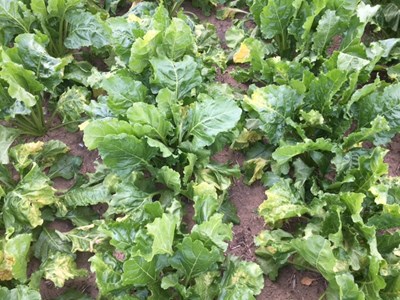BBRO News item – 5 March 2021
The things you might not know about the Cruiser SB derogation……
Following the news on 2nd March, that the Virus Yellows forecast did not trigger the economic treatment threshold of 9% national infection for use of Cruiser SB, there has been a lot of activity, in the press and on social media, and several inaccuracies and misconceptions reported. As Head of BBRO, I want to put a few facts straight and let you know that myself and the team are fully supportive of the decisions taken on the Cruiser SB derogation. We will continue to support you all with appropriate and timely crop management advice throughout the season so please keep a watch out for the latest BBRO information.
Dr Vicky Foster, Head of BBRO
- Why was a derogation approved if it could not be used?
An emergency authorisation to allow the sugar beet industry to use Cruiser SB on seed was applied for, and authorised, following the devastating levels of VY in 2020. The application was made jointly by the NFU and British Sugar, with technical input from BBRO. The specific terms and conditions of its potential use, including the economic trigger point, were agreed in October 2020 when the application was submitted to HSE & DEFRA. The industry agreed from the start this would be based on a national forecast and it could not be done regionally or locally. This may be an option for the future, but we do not yet have robust regional data available for this to be achieved.
- Seed treatment versus foliar sprays – both are based on risk and monitoring
The Cruiser SB seed treatment is applied to sugar beet before planting and aphids are observed in the crop. Aphicide spray applications are based on aphid thresholds being observed in the crop. To enable responsible use, the use of the seed treatment in 2021 was based on the forecasted risk of the crop (9% national infection expected). Foliar insecticides are applied once a threshold has been met (1 green wingless aphid per 4 plants up to 12 true leaves). Both approaches require controlled and limited use.
- How well would the seed treatment have worked in 2021?
There are several things that impact on product efficacy and this is not a simple answer, but what we do know is the seed treatment is targeted to provide aphid control for up to 10 weeks post drilling. The Rothamsted model also predicts the date of first flight of aphids into the crop. Due to the cold January and February in 2021, first flights are not expected until around the 3rd week in May. Depending on drilling date this could have had an impact on Cruiser efficacy in late May, e.g., for earlier drilled crops this would have been more of a challenge and would not have been as simple as controlling early aphid flights as in 2020.
- How the VY forecast model works
The VY forecast is derived from a complex model that considers aphid biology, aphid incidence (based on suction trap catches) in the previous year as well as the impact of weather (based on two weather stations in the core sugar beet growing areas: Broom’s Barn and Cranwell) on aphid overwinter survival during January and February. It is important to state whilst weather is an important factor in the model it is not the only consideration. The forecast does not use weather data from Rothamsted in Hertfordshire.
- How much confidence can we place in the model?
Aphid monitoring has been undertaken by Rothamsted since 1965 and there is a significant bank of data, based on forecast and actual aphid incidence, that allow us to check the accuracy of the model every season. In 2018, a winter like 2021, predicted a low VY incidence (6-10%) in the absence of treatment, in 2021 the forecast predicted a high level of incidence (70-90%) and this was observed. We are very confident the model has been tried and tested over six decades. Without such a robust VY forecast and a strict trigger threshold it would have been highly unlikely the derogation would have been approved by DEFRA.
- Location, location, location
We are confident the risk across the whole beet area in 2021 is low. Whilst there are variations in regional temperature these are generally small in their effect on virus risk compared to the overall effect of a cold winter with a high frequency of frosts. It is important to remember that a proportion of aphids will be migrating into regional areas from other areas, so it is the conditions in these other areas which can be just as important. In a specific location the number of potential sources of virus such as other hosts crops including other beet crops still in the ground, storage clamps, spoil heaps and weed beet all have an important effect on the regional virus risk.
- Ongoing monitoring
As well as the widely spread yellow water pan network BBRO runs during the season, we are also undertaking regular monitoring of crops early in the year to provide information on aphid numbers. This is done by visiting various sites but also by growers sending in plant samples for analysis in the plant clinic. So far in 2021, we have found extremely low numbers of aphids.
- Not all aphids are equal.
It is important to note there are different aphid species in arable crops and they do not all have the same biology, behaviour, and susceptibility to cold weather. Some aphids overwinter as eggs, others like Myzus persicae survive as live adults. So, what is predicted for Myzus persicae may not be translated to other aphid species. BBRO focuses on M. persicae as it’s the main vector for transmitting virus yellows in sugar beet.




